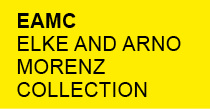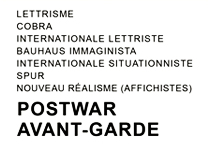LE LETTRISME ET SON TEMPS (Aufstand der Jugend)
Impressions from the Lettrist Colloquium at the German Centre for the History of Art,
Paris on 26 and 27 March 2015
Thomas Kirchner, new Director of the German Centre for the History of Art (DFK) in Paris has come up with an idea that is particularly nice and at the same time ground-breaking. The „Journées Lettristes“ hosted by the DFK were held in memory and in honour of the deceased German collector of the French Avant-garde, Elke Morenz.
What made the event ground-breaking, was that it was the first time that major academics from the areas of art and literature and from several countries met to discuss the life achievements of this group from the fifties and sixties, which had such a significant multidisciplinary impact. The event was funded not only by the DFK as its initiator, but also by the Centre Georges Pompidou, the Bibliothèque Nationale, INHA (National Institute of the History of Art), several French universities and the Berlin EAM Collection, which focuses on Lettrism.
Sarah Wilson from the Courtauld Institute placed the Lettrists within the tradition of Dadaism and Neo-Dadaism. Fabrice Flahutez and Frédéric Alix from the Université Paris Ouest Nanterre, Nicolas Liucci-Goutnikov from Centre Georges Pompidou and many others took a closer look at the innovations of Lettrism in film, photography and literature. After all, the movement’s founder, Isidore Isou, wrote the book Youth Uprising in 1949, which practically predicted the events of 1968 20 years before they even happened. Two years before that, the first publication by the then 23-year-old, Introduction to a New Poetry and a New Music, had been published by Gallimard. It is hardly surprising that the Lettrists were seen by the “officials” in French cultural policy as a counterculture, perhaps even as an “underground” movement. Julia Drost from the DFK vividly presented the innovative development of the Lettrists in the plastic art, which works in a “dissipating” and “hypographic” manner with letters and characters within a self-contained system.
Even if many works, in particular those of Maurice Lemaître, are strongly critical of de Gaulle, one is drawn in by the aesthetics of other works by this Lettrist – one of the very first – who was born in 1926, and of the works of his colleagues. Some of the Lettrists from this founding period, for example, Francois Dufrène and Gil J. Wolman, became more well-known under a new flag (New Realism and Situationaism) in plastic art and in sound poetry than those who remained loyal to Lettrism.
A choreographed musical performance given especially for this Colloquium by Frenchman Frédéric Acquaviva, now living in Berlin, brought back to life the mythical post-war world of a liberated Paris with sound poems that were written by Lettrists and performed by them personally in, among other locations, the famous cellar club “Tabou” in St. Germain des Près that was frequented by the existentialists.
Swana Pilhatsch-Morenz



